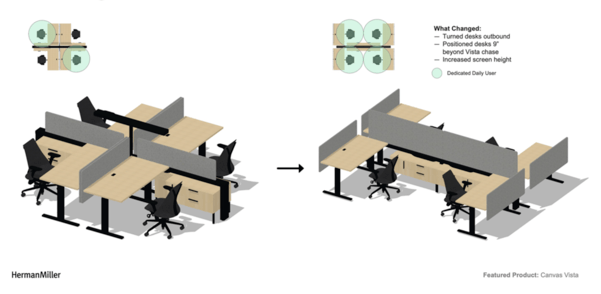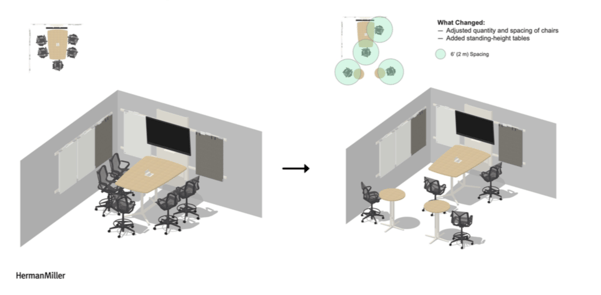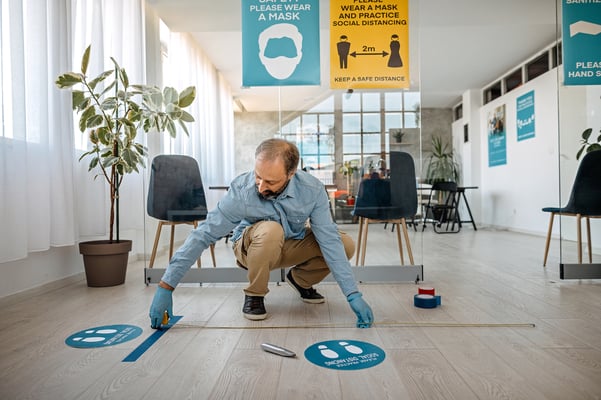Companies that have been operating remotely due to the COVID-19 pandemic are realizing the pros and cons of a remote workforce. While some teams have improved productivity, others may have suffered by way of decreased morale, collaboration, and innovation. The pains of brainstorming sessions over a video conference platform with video lag times, awkward silences, and repeated starts and stops are real, not to mention the occasional appearance by a needy child, playful pet, or other distraction.
Most companies are looking for ways to safely bring at least a portion of their workforce back to the office sooner than later and realize that their corporate spaces may not comply with current infection control recommendations. Many interior design firms can offer help on how office design, furnishings, and layout may need to change, along with the behaviors of those who work there.
Office design trends in recent years emphasized “bringing down walls” to help bring in natural light and allow workers to see each other across the room. It was done in part to help foster teamwork and create a collaborative environment. In light of COVID, office designs are returning to the addition of higher screens or partitions to help create separation between workers.
The effectiveness of these measures is under scrutiny, however. The safest measures involve creating a physical distance of at least six feet, not just a physical barrier which might create a false sense of security. Research has shown that particulates from a cough or sneeze can easily travel under or around a barrier.
To overcome the challenge of needing additional square footage to accommodate the six-foot rule, some companies are asking a segment of their employees to continue working from home. This allows employers to reconfigure office space at a safer distance between workstations to accommodate those returning.
In the example below from Herman Miller, a leading provider of commercial furnishings and a thought leader in corporate design, you can see that the configuration was changed to eliminate having people face each other, and a higher partition was added between adjacent workstations. In this before and after example, the changed layout takes up only a slightly larger footprint without reducing the number of seats.

Other workspace examples might include the removal of a few workstations and reconfiguring those that remain to allow for adequate social distancing between employees. Conference rooms and collaboration areas also need to be reconfigured to allow for social distancing. Another example below from Herman Miller shows how the simple addition of a couple standing-height tables provides adequate space.

Beyond Zoom and Microsoft Teams, technology might play a role at some workplaces by way of an app that allows employees to select where in the building they plan on working for the day. Need a private work space to focus on a major project, or is a bigger room needed to accommodate a group for collaboration? The app shows which areas are sanitized and available and marks it as unavailable to others once you select it. Simply notify the app when you’re done. It won’t show that it’s available again until the room has been thoroughly cleaned for the next occupant.
A major trend as a result of the pandemic is installing touch-free features. Some contactless features may be as inexpensive as installing a foot pull on a door. Others may be more involved to include motion sensors or scannable keycard access where manual keypad entries were once required at doorways.
Restrooms are a major consideration for touch-free features, including automated sinks, soap dispensers, and more. We expect to see an increase in deeper sinks that allow more thorough cleansing like those found in hospitals where surgeons prepare for the operating room.
Toilets and bathroom stalls are coming under scrutiny, too. While self-flushing toilets are a start, some experts suggest that the forceful flushing action of many toilet models actually aerosolizes the contents and sends a plume of bacteria and tiny particles into the air. Are you as grossed out as we are? A temporary fix might include closing off every other stall or urinal to add distance, placing floor-to-ceiling barriers between stalls, or installing lids on toilets.
We’ve all seen the decals affixed to floors of retail store check-out lines and aisleways encouraging social distancing of six feet or more. These visual cues and reminders are also conducive for corporate spaces, both for public access areas like lobbies and where employees may congregate. Some companies are creating designated one-way hallways, entrances, exits, and traffic patterns to minimize contact. When paired with additional signage and clear communication of expectations, these measures can have a significant impact.

In today’s environment, designers and facilities managers who select finishes and materials for workspaces are just as concerned with cleanability as they are with how it looks. Some commercial finishes, like those used in healthcare facilities, contain antimicrobial materials and are being integrated into general corporate spaces more frequently. Thankfully, finishes that are intended to deter microbes and be cleaned frequently aren’t as utilitarian-looking as they once were.
It’s important to remember that the cleaning agents and disinfectants recommended by the CDC to kill pathogens can contain some very harsh chemicals, and some common household cleaners don’t actually kill germs and bacteria. Check the labels and manufacturer’s specifications on your furnishings, laminates, whiteboards, chairs, workspaces, and more to make sure cleaning products are compatible and won’t damage surfaces or fade materials.
Many companies are changing their philosophies on traditional desk jobs after being forced to work remotely during the pandemic. Recognizing which teams it works well for and those that may have struggled has helped them strategize next steps.
Some employers provide a stipend to help create a productive at-home office for those who may continue working remotely. It might be as simple as supplying them with an ergonomic chair or standing desk to help set them up for success. Of course, ensuring they have the technology they need is critical, too. Encouraging select employees to work remotely frees up corporate office space, allowing employers to repurpose that space and make it COVID compliant.
Companies that are ready to bring their workforces back to the office are encouraged to establish protocols and communicate them with purpose. Employers need to go beyond installing strategically placed hand sanitizing stations. It’s critically important to implement recommendations based on OSHA’s guidance for returning to work to help mitigate the risks of spreading COVID-19.
Protective measures are only as effective as the efforts of individuals to practice proper hygiene, maintain social distances, clean surfaces, wear masks, and stay home when they feel sick. As with any good team, when everyone works toward the same goal and understands their individual responsibilities, you’ll have a better chance of success.
Maximizing space, reconfiguring workstations, and making your work environment as safe as possible may require help from a professional designer. The Samuels Group, along with their furniture solutions services, can help strategize ways to equip your company and your employees for success. Contact The Samuels Group team to get started.
These stories on Construction